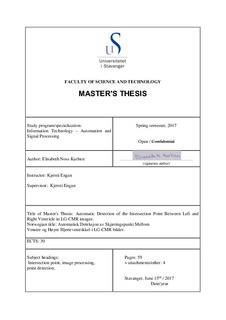| dc.contributor.advisor | Engan, Kjersti | |
| dc.contributor.author | Karlsen, Elisabeth Noss | |
| dc.date.accessioned | 2017-09-19T13:55:43Z | |
| dc.date.available | 2017-09-19T13:55:43Z | |
| dc.date.issued | 2017-06 | |
| dc.identifier.uri | http://hdl.handle.net/11250/2455573 | |
| dc.description | Master's thesis in Cybernetics and signal processing | nb_NO |
| dc.description.abstract | Each year Myocardial Infarction affects millions of people worldwide. Approximately 66% of those experiencing a Myocardial Infarction survives, but are at a higher risk of heart related complications and another Infarction. Approximately 30% of post Myocardial Infarction Patients will experience two- or more Infarctions.
A Myocardial Infarction causes damage to the heart muscles, which is later healed by forming a scar at the damaged area. Scarring on the heart impacts the hearts ability to pump blood around the body, how big of an impact depends on the scars size and localization.
When cardiac magnetic resonance images are used to study the scar, general anatomical reference points can be used to define the scars size and/or localization in terms of the angular position. Two meaningful reference points, similar in all patients are the left ventricles center point and the point where the left- and right ventricle intersect.
The reference points are often manually marked by a cardiologist. Since this is a time- consuming work, it is desirable to automate this process. Detection of the left- and right ventricles center point has not yet been automated. The objective of this thesis is therefore to determine whether the intersection point can be automatically found with use of image processing, in terms of image segmentation and point features, in terms of texture and location.
The system presented in this study showed promising results, with room for improvement. 109 images, from 15 different patients, with various contrast resolutions, placement of the scar and eventual enlargement of the heart were tested.
Results showed that 70% of the images where an intersection point was detected were classified as a satisfying result, while the average Euclidean distance between the automatically- and real intersection point was 10,46 pixels. After an interpolation method was used to find the missing intersection points, the results were somewhat worsened to 67% and 11,13 pixels. | nb_NO |
| dc.language.iso | eng | nb_NO |
| dc.publisher | University of Stavanger, Norway | nb_NO |
| dc.relation.ispartofseries | Masteroppgave/UIS-TN-IDE/2017; | |
| dc.rights | Navngivelse 4.0 Internasjonal | * |
| dc.rights.uri | http://creativecommons.org/licenses/by/4.0/deed.no | * |
| dc.subject | informasjonsteknologi | nb_NO |
| dc.subject | kybernetikk | nb_NO |
| dc.subject | signalbehandling | nb_NO |
| dc.subject | image processing | nb_NO |
| dc.subject | point detection | nb_NO |
| dc.subject | intersection point | nb_NO |
| dc.subject | cardiac magnetic resonance images | nb_NO |
| dc.subject | automatisering | nb_NO |
| dc.subject | MRI | nb_NO |
| dc.title | Automatic Detection of the Intersection Point Between Left and Right Ventricle in LG-CMR Images | nb_NO |
| dc.type | Master thesis | nb_NO |
| dc.subject.nsi | VDP::Teknologi: 500::Informasjons- og kommunikasjonsteknologi: 550::Teknisk kybernetikk: 553 | nb_NO |

